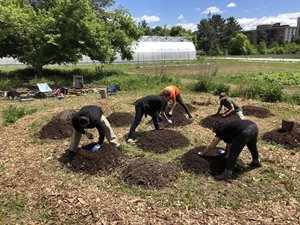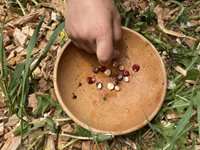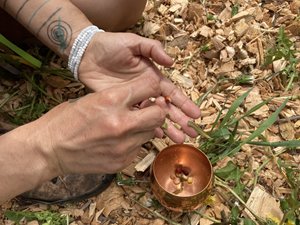Building Bridges - Sweet Grass Roots Collective
 Sweet Grass Roots Gardening 2021, photo by Emmy Pantin
Sweet Grass Roots Gardening 2021, photo by Emmy Pantin
“Parks are a bridge, between public and private realms, between urban and the natural world,” says Emmanuelle Pantin. Pantin is one of the founders of Sweet Grass Roots Collective. Founded in 2018 by three artists – Joce Tremblay, Jennifer LaFontaine and Emmanuelle Pantin, Sweet Grass Roots Collective is a recipient of a 2021 TAC Animating Toronto Parks grant. Animating Toronto Parks grants recipients also get support from Toronto Arts Foundation’s Arts in the Parks program.
Acting as a bridge between different spaces, physical and otherwise is a key role played by Sweet Grass Roots Collective. All three artists come from different Indigenous communities, and bring their traditions to their shared work in Toronto. While centering Indigenous knowledge is the key to their land-based work, they don’t prefer any one Indigenous practice or belief – focusing instead on bridging diverse traditions.
The etymology behind their name – Sweet Grass Roots Collective, captures the essence of what the collective seeks to do, centering Indigenous knowledge as the first knowledge of this land, while also bridging different communities – Indigenous, refugees, immigrants, and settlers.
 Sweet Grass Roots Gardening 2021, photo by Emmy Pantin
Sweet Grass Roots Gardening 2021, photo by Emmy Pantin
Sweet grass is used as traditional Indigenous medicine, to bring positivity to a space. The use of the name is reflective of the rich Indigenous knowledge connected with the land that Sweet Grass Roots Collective seeks to bring forth through their work. “[Through a land-based approach] We want to centre, Indigenous knowledge as the first knowledge of this land,” says Pantin. “There are ways that Indigenous people understood the land, interacted with the land that is very very valuable.”
The second part of the name – Grass Roots comes from the community organizing principles of the collective. While explaining the importance of bridging these gaps between different communities and Indigenous communities Pantin says, “All newcomers, immigrants, refugees, and settlers are treaty people, yet they are not taught about their responsibilities to the land, to the Indigenous people.” Through their work they have noticed how several newcomers who themselves have their own colonial experiences, or experiences of violence, are able to understand the experiences of the Indigenous community through that framework. However, this is not a one-way process. Pantin talks about how Sweet Grass Roots Collective also learns from the diverse and rich cultural traditions of the immigrant communities.
Working in collaboration with Black Creek Community Farm, Sweet Grass Roots Collective is working to re-indigenize urban spaces through earthwork, art, media and storytelling. Connection with the land is an important part of Indigenous identity. Sweet Grass Roots Collective believes that when Indigenous people are cut off from the land, they are also cut off from the ceremony and culture. This rupture between Indigenous peoples and the land is heightened even further in urban spaces. By taking up space in urban environments Sweet Grass Roots Collective seeks to create bridges back to the land. Through community art they want to make Indigenous spaces visible. Pantin observes that a land might be a part of urban space now, or might even be a public park, but it doesn’t take away from the fact that it is Indigenous land and that there are ancestors buried there. They define their work as art-based, land-based, cultural and ceremonial.
Initially designing their project before the pandemic hit, Sweet Grass Roots Collective was aiming to bring different communities together at Black Creek Community Farm, engage in community-art, storytelling and cultural teachings to centre Indigenous worldview through their art-form. “Our primary artistic method is digital storytelling,” says Pantin. “So we were going to be bridging traditional forms of storytelling with contemporary technologies of media.” Being on the land however was an important part of the project.
Once social distancing regulations were put in place to prevent the spread of COVID-19 it was no longer possible to gather on the land. However due to the digital aspect of their work they were able to quickly pivot. While the team gathered on the land, made recordings of their work, they disseminated it through social media. “In many ways we were able to expand our community because of technology beyond those who could physically be there,” says Pantin. “Our hope is that we are able to come together in the Fall – to have a festival, where we can gather as a community, Indigenous, non-Indigenous, to celebrate the land.”
 Sweet Grass Roots Gardening 2021, photo by Emmy Pantin
Sweet Grass Roots Gardening 2021, photo by Emmy Pantin